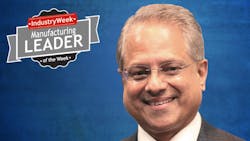Bell and Howell: Historic Company Moves Into IoT Space
Survival is based on instinct. While this is true for people, it’s also true for companies.
The intuition we follow when deciding which path to take is similar to a company’s roadmap for product development. Bell and Howell is a good case in point. The company, which is remembered by some as a manufacturer of motion picture machinery, is aiming to make its mark in the IoT world through its smart locker package delivery system.
Over the years the company has undergone changes which have moved it from motion picture machinery to an information technology company. It has also changed owners and names, but is now back to its original name. The services it provides include production print and mail, parcel packaging, management and logistics, card and secure ID production, currency management, robotics and other industrial mechatronics.
And it’s in the parcel package part of its business that Ramesh Ratan, CEO of Bell and Howell, sees as a key opportunity that will keep the historic company on its trajectory to future success.
“Of the many factors driving innovation in the world of ecommerce package and parcel supply chain and logistics, “speed” or “same-day delivery” has become the Holy Grail of modern-day Silk Road crusaders,” Ratan wrote on his company blog.
The last mile logistics market, the name given to that part of the supply chain that is responsible for delivering packages directly to the customer, is heating up. With the increase of eCommerce as a preferred purchasing method, coupled with quick delivery expectations, the model of how to satisfy customers has changed. Add to this the very real threat of “piracy” (bandits who steal packages off porches) and Bell and Howell saw an opportunity.
So the company got into the smart locker business. Smart Lockers, or intelligent parcel terminals, offer 24x7 delivery, pickup and drop-off of small to medium-sized parcels.
“Smart lockers are a huge improvement to delivery to doorstep," explained Ratan, the former Pitney Bowes executive who took over as CEO in 2013, at his company’s booth at MODEX in April 2016. At MODEX the company introduced its latest innovation in this space called PackRobot.
PackRobot locker uses a 3D lift system that measures each parcel’s dimensions, and dynamically configures a locker slot to optimally secure the parcel. It also has adjustable internal climate control and therefore can be used for parcel delivery involving temperature-sensitive food and groceries.
Using a integrated smartphone app and a high-speed lift consumers can retrieve a parcel in as little as 10 seconds.
“For every 6 truckloads that would have gone to individual houses, it only takes one truck to a smart locker." Ratan pointed out. Aside from those large savings, the flexibility of the locker creates a number of opportunities. In addition to placing lockers at key points in crowded cities ( such as train stations in New York City), retailers who have brick and mortar buildings can place the smart locker in the parking lot to allow customers to get delivery without the need for customer service. This method is growing as retail stores are offering customers who order online the opportunity to pick up the item at the store.
The company partnered with Cleveron, a postal technology company based in Estonia, to bring this technology to North America. “Cleveron terminals are installed at 800 locations across Europe, with over 61,000 lockers delivering 450,000 parcels each month,” said Ratan. “We anticipate that demand in North America will be tremendous." In fact Bell and Howell is projecting a potential of 15,000 parcel terminals in North America in the next five years.
While this use of smart machines is touted as an IoT application Ratan prefers to call this market the Iot of Things and People. “Machines will never replace human instinct, intuition and interaction,” he explained while demonstrating the parcel system at MODEX and delivering a chocolate bar to me.
He explained it best through a blog he has written.
Our technicians have had service dispatch applications for a while, first through BlackBerries and soon iPhones and other smart devices. This allows our men and women in the field to use the app as an extension of themselves. Through GPS, video, barcode scanners and tags, this helps us to enable not just the “Internet of things” but the “Internet of people and technology.” It’s a unique concept that empowers the mutual exchange of information that makes both our people better through technology, and our technology better through our people.
He believes that his company's reputation for outstanding customer service will be its competitive advantage in this space. The company built a world-class training center at its Durham, N.C. headquarters. "Our training program is one of our biggest assets," says Ratan.
His workforce is trained in mechantronics which is a multidisciplinary field of engineering that includes a combination of systems engineering, mechanical engineering, electrical engineering, telecommunications engineering, control engineering and computer engineering. The need to understand all of these fields is what will continue to advance automation says Ratan.
"Neither humans nor technology can optimally solve problems on their own," says Ratan. "It’s the interplay between human judgment and technical data that combine to enhance operations.
